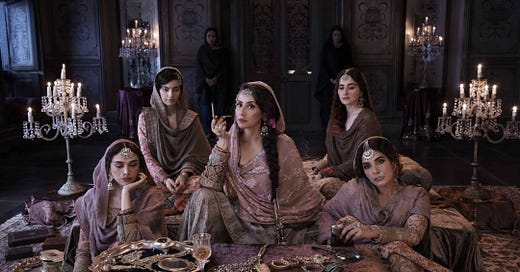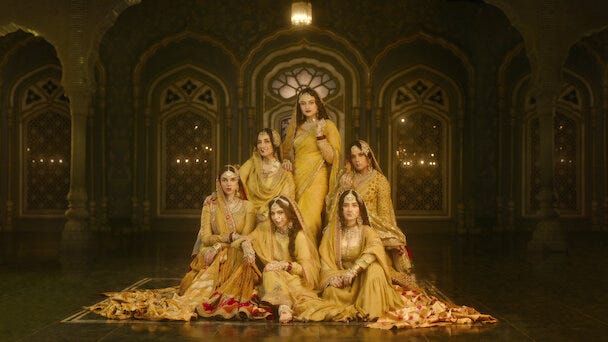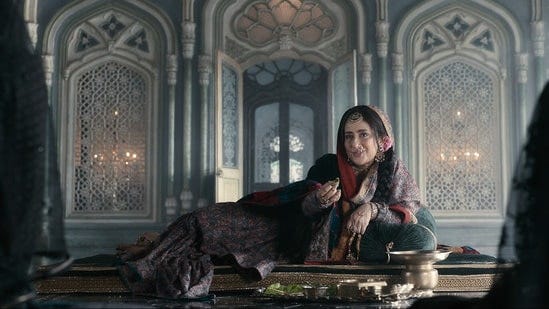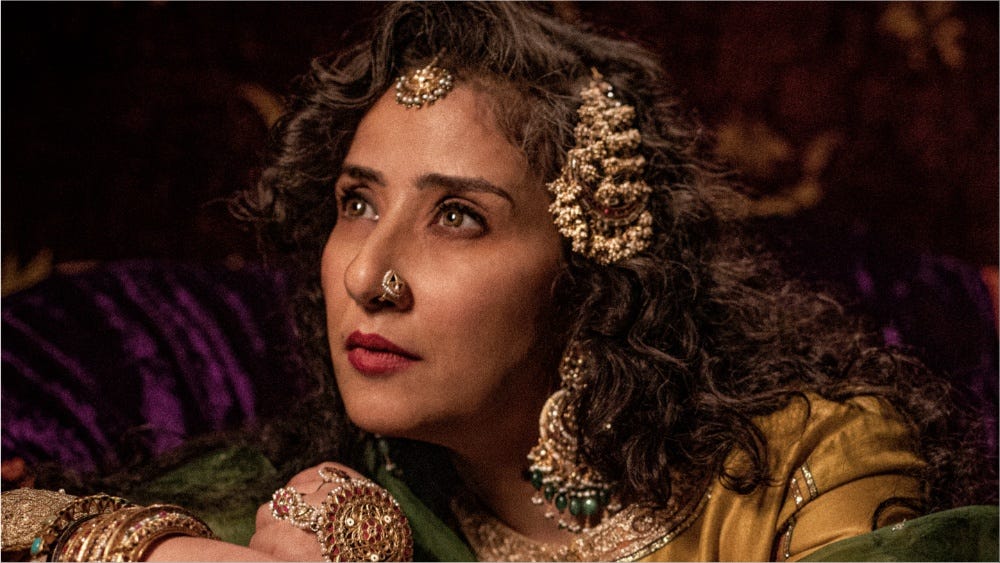Everyone's Talking About Heeramandi, and I'm Simply Adding To The Noise
I have sat with my emotions about the show for enough time now...
I really had no intention to watch Sanjay Leela Bhansali’s (SLB) latest work for Netflix, but it came out on Labor Day (which was a holiday) and by 1 PM, I had seen that opening shot enough times on Instagram stories- sadly, my FOMO got the better of me. I finsihed the last episode right at midnight and I have, since then, just sat with my feelings.
Let’s talk plot first…
My initial critique will purely be on storyline, plot, characters. The biggest critique of the negativity the show has received has been that SLB creates fantastical worlds and never promised a historical film and that if one wanted history, they should watch a documentary (I’ll break this down too later). I accept that critique in small part, but that being said, the least we expect from any film or story is a good storyline, is a good plot. Heeramandi did not have a good plot, it did not have fleshed out characters, and worst of all, the eigth episode of where EVERYTHING changes, EVERYTHING flips on its head, and the tension of the last 7 episodes is forgotten.
The main tension of the show is between Malikajaan (Manisha) and Fareedan (Sonakshi)- this tension is one based in revenge, but also is one steeped in a fight between tradition and modernity. The war between Malikajaan and Fareedan is played through their proxies and pawns; Malikajaan’s daughters Bibbojaan (Aditi) and Alamzaib (Sharmin), and through Malikajaan’s sister, Waheeda (Sanjeeda). This tension is played up and given the most importance for 7 straight episodes- so much so that the first 2 episodes are essentially a set up and justification for the venom these women hold for each other. This storyline is sold to us repeatedly.
It is also through this tension that the writers of the show hope to justify the horrendous acts Malikajaan and Fareedan commit. In literature and in Bollywood, tawaifs and huzoors (the head of a tawaif household) are often shown as cruel and evil women. Heeramandi takes this trope and runs a marathon with it. Malikajaan and Fareedan are severely unlikeable characters. I couldn’t bring myself to feel for either of them- the horrible things in their past explain their “present state” but it is a hard ask for the viewer to feel for either of them. Instead you feel for characters like Bibbojaan and Alamzaib more. Malikajaan and Fareedan are in fact so much like each other, and this comes through in the end too, but the people and the lives they plough through in the process of their victories, makes for uncomfortable characterizations.
A switch and change does happen for both characters towards the end. It is the arrest of Alamzaib and the murder of her lover, Tajdar, that is the catalyst for the main characters to change ways- the circumstances that bring about this change, and further the emergence of a wider “resistance” sentiment within Heeramandi, is a just resolution for the plot- but my question is; why does it happen SO FREAKING LATE! SLB has said in his interviews that Heeramandi was a project meant to celebrate the tawaifs who gave up so much for azadi, but why is that for 7 episodes only Bibbojaan is consistent in her support for the resistance movement, and why is it that only in episode 8 does this celebration of resistance within Heeramandi is brought up? For 7 episodes (which are 7 hours), you have asked your viewers to invest their emotional emergy in this feud, and then in the 8th hour, you ask them to shed that and watch the resistance movement take over. It felt like betrayal of plot. Bibbojaan’s longstanding association with the azadi movement was the perfect hook to bring to light Heeramandi’s association with the movement, but they used it too late.
Other than this, there are plot points that are brought up and never resolved. For example, Malikajaan has a son who is taken away from her (this happen in the opening scene which is depicted as 1920- the show then leaps forward to 1945). On his wedding night, after he has rejected Malikajaan’s adopted daughter, Lajjo, she confronts her son, Zorawar, and lays open the truth of his lineage, for he believed up until then that he was of noble blood and he looked down on Heeramandi and at Tawaifs in general. This climatic scene happens, and that’s it- we never hear about this again.
The show also gives importance in the beginning to the gramaphone and shows Malikajaan’s displeasure at the technology of the time- they use this plot line to show her attitude and arrogance as the huzoor of her house- but it was also an interested plot line which was never explored again.
(I’m fully writing this on the fly, excuse the scattered thoughts)
Another thing that was missing in the plot was…….tension. There were points of severe tension in the plot, like when the resistance tries to attack a British weaponry stash and they’re found out. This is an insane plot line however, that scene sadly felt boring. Heeramandi pours tension into Malikajaan and Fareedan only- the rest of the show feels kind of one note.
What is obvious to me, watching the show, and watching interviews of SLB is that the ambition was too big. He wanted to show tawaif culture, he wanted to show internal politics, he wanted to show Lahore (he didn’t), he wanted to show the azadi movement. It was too much and the plot drowned in its own ambition.
Now, I want to come to the other things I didn’t like.
*deep breaths*
A friend of mine, Shmyla (her twitter is private so I won’t post the tweet here), made a comparison with Bridgerton, that I really liked. Bridgerton is unapologetically ahistoric. Ahistoricity is built into the show, however, it still does its best to be true to that time period, and it tries to do so convincingly. Heermandi, in execution, is an ahistoric show however, it inteded not to be. SLB is known for glamorization and dramatization, we know this. But whenever and wherever he has built a plot on a real person or on a real world timeline, he has done research and kept elements of fact in the plot- this was not the case with Heeramandi.
First of all, we were looking at 1945 in Lahore. How is everyone in this show Muslim? Lahore had a massive Sikh population and had a sizable Hindu population. Heeramandi was not only built on Muslim tawaifs. Also Heeramandi wasn’t only frequented by Muslim nawabs. It is a strange choice to make. Any amount of research into that time period would have brought this glaring fact to light.
The show is also confused as to where it is. The Muslim heaviness can be explained in the Urdu heaviness of the show too. Again, we are in 1945, Lahore. Lahore is in Punjab. Urdu was spoken, however pervalence of Punjabi and Punjabi songs and culture did play into the culture of Heera Mandi at the time. Songs like Sakal Ban were known in Lahore at the time, however, they were more prevalent in Awadh culture and tradition. The shows language, its demographics and its tehzeeb (manner) depict more of what research indicates Lucknow to be like, and less of what Lahore was perceived as.
Videos of stalwarts of the Pakistan entertainment industry speaking about Heera Mandi prove this fact. It was place of culture and of music, and a place where Punjabi classical songs and stories were passed on- however, Heeramandi (the show) almost clinically wipes that away. The Urdu-washing of the true stories of Heera Mandi can only be described as deliberate- a callback to Bollywood’s old habit of portraying all Muslims and Pakistanis are kajal wearing, topi wearing, Urdu speaking. The nuance of the actual Heera Mandi is lost of the show Heeramandi.
The only characters of Heeramandi that speak Punjabi are the domestic staff of the household, their assistants, their maids, their drivers. The memsaabs and sahabs speak Urdu or English, and the kaamwalas speak Punjabi- again, records of Punjabi classics being sung there refute this. This divide between class and language becomes more relevant post independence, not before it.
Lastly, I’ll speak to the resistance and azadi movement.
Where is Heeramandi set?
Lahore.
When?
1945.
Lahore played an important part for the Muslim League’s success. Lahore is also where the movement for Pakistan had its beginnings. At the same time, Lahore was a diverse city, and many believed that if cities are being decided on the basis of what religion holds the majority in a city, then Lahore would go to India. These are facts and they show that Lahore was a main centre of power, and the city was part of a major power tussle between the two sides of the independence movement.
All of these facts are absent from Heeramandi. The show simply overlooks the nuance of that moment in time. In 1945, the Muslim league was popular. The call for a separate Muslim homeland was popular. For a show that depicts only Muslim characters, it is hard to believe that within the tawaifs there wouldn’t have been discussion of which side to side with. It is hard to believe that lines were not drawn in the sand between who supported the Congress and who supported the Muslim League. If you are going to make a show about the fight for independence, and if you’re going to celebrate the tawaifs who gave their lives for the cause, and if you’re going to base this in the real place of Heera Mandi in Lahore, then you have to add that nuance. The plot was already overflowing with themes, might as well have added another one.
If you were going to be ahistoric, then be fully ahistoric. Choose a name that hints to Heera Mandi, make up a city fighting for independence or shift the story to Lucknow entirely.
I’ll end this rant with a last thought. I believe it might have been the Film Companion review of Heeramandi that said that Indian directors know how to make movies. Netflix has only now come in, and only now are we looking at mini series and episode based shows. They argued that Indian directors don’t know how to stretch a story for a series- they become overambitious. The reverse is true for Pakistani directors- we love our serials and subsequently overstretch our movies.
Heeramandi was ambitious- and sadly that ambition was the series’ own demise.
I wanted to also talk about the twitter fallout of Heeramandi and how its instigated a lot of random ass “hot takes”. All I’ll say is, I love Lahore. The city deserved better. The story of the tawaifs of Heera Mandi deserved better. And if a show or production fails at the basics of storytelling, as viewers we have the right to not be impressed.










Haha true! This might be SLBs weakest project till now.
Love this incisive review!! I completely agree about the resistance and history part!!